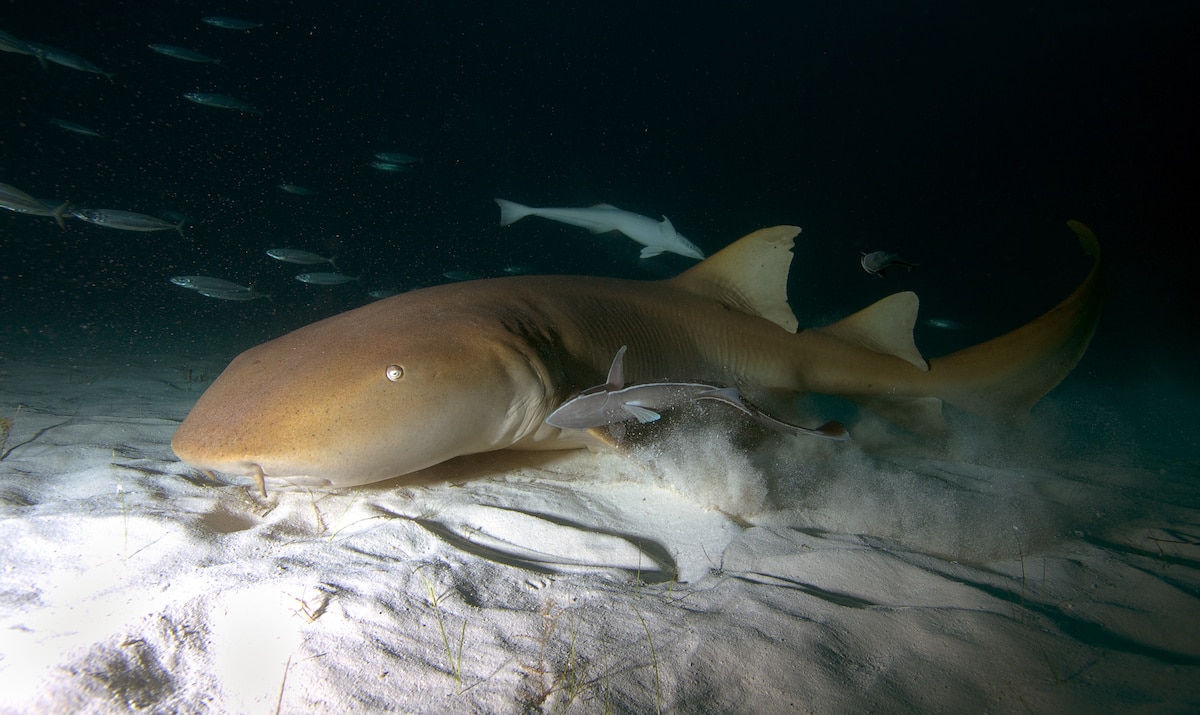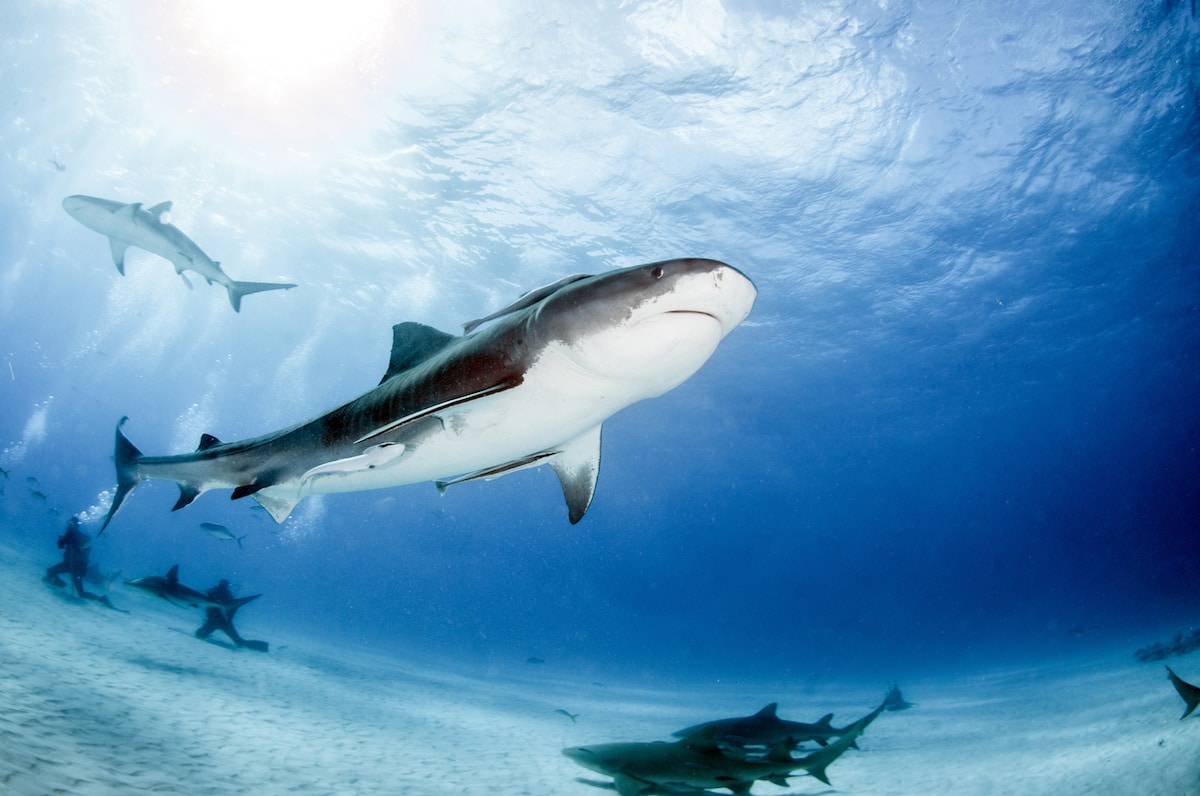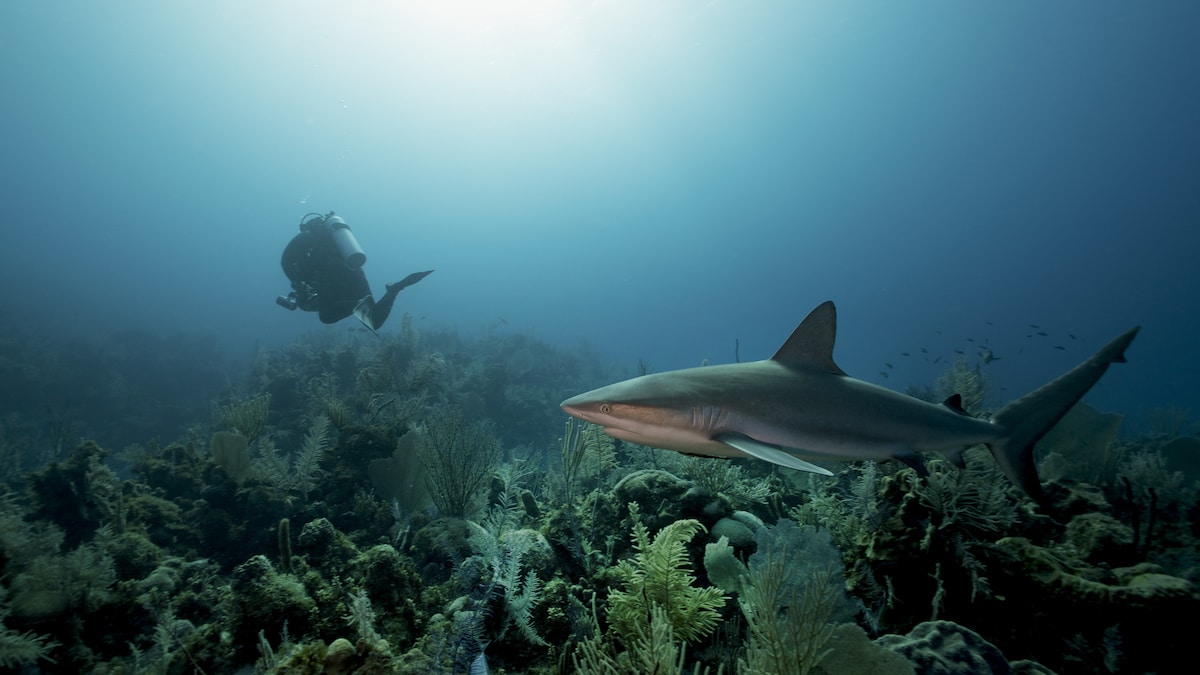This article was written by divers and writers at LiveAboard.com
News
Your Ultimate Guide to Shark Diving

In celebration of SHARK WEEK, here is your Ultimate Guide to Shark Diving…
Shark encounters are high on the list for many divers and rightly so. Nothing beats the thrill of seeing a shark during your dive or joining a dedicated shark diving safari.
Thankfully there is a variety of excellent shark diving destinations to choose from these days. Pick your preferred type of shark and read on to find out where you can swim with them.
Great white sharks
Renowned for its relatively warm water compared to other great white shark diving destinations, Guadalupe is the premier destination for encounters with these iconic sharks.
Calm waters make it easy to spend time in the cage, be that at the surface or at depth, and being crystal-clear, the water is also ideal for photographers wanting to capture that perfect shark shot.
When is go: Visit in July and August to see numerous energetic male sharks, or October and November to see the huge female sharks Guadalupe is famed for.
Our liveaboard top pick: The MV Horizon is a great budget-friendly option for divers and non-divers to go cage diving.
Whale sharks
If you’re a fan of whale sharks, you have plenty of world-class dive destinations to choose from where you can swim with these spotty giants.
An ever-popular dive choice, the Maldives has numerous whale sharks to encounter. Try scuba diving Ari Atoll, Huvadhoo or Thaa atolls for your best chance of seeing whale sharks there.
The wild and remote Galapagos Islands are another top dive destination for whale shark encounters, as is Ningaloo Reef in Western Australia.
For somewhere more off the beaten path, take a liveaboard diving trip to Cenderawasih Bay in Indonesia, Djibouti or Madagascar.
All three destinations are known for the whale shark swims and are becoming more popular as word gets out.
When is go:
- Ari Atoll: December to April
- Galapagos: June to December
- Ningaloo Reef: March to June
- Cenderawasih Bay: July to September
- Djibouti: November and December
- Madagascar: September to December
Our liveaboard top pick:
- The Deli, a beautiful Turkish schooner, is a great option for sailing and diving Djibouti’s pristine reefs with just 12 other guests.
Great hammerhead sharks
Another popular shark diving choice, great hammerheads are a fantastic species to dive with.
Go liveaboard diving at Bimini, Bahamas to dive with these large sharks over white sands and in clear blue waters.
Rasdhoo Atoll in the Maldives and French Polynesia’s Rangiroa and Fakarava atolls are also both excellent options for swimming with these well-known sharks.
Whilst diving French Polynesia, you’ll also likely see the huge schools of grey reef sharks this idyllic destination is known for.
When is go:
- Bahamas: December to February
- Rasdhoo Atoll: October to March
- Tuamotu Archipelago: December to March
Our liveaboard top pick:
- The Bahamas Master offers Tiger Beach and Bimini combo-safaris, allowing you to dive with numerous species of sharks in one dive trip.
Schooling Scalloped Hammerheads
To dive with hammerhead sharks in large numbers, choose scalloped hammerheads. They are known for schooling in huge numbers at some of the world’s best dive destinations.
Cocos Island in Costa Rica is the best-known destination for schooling hammerheads, closely followed by scuba diving the Galapagos.
You can also spot scalloped hammerheads at Malapascua’s Kimud Shoal.
When is go:
- Cocos Island: May to November
- Galapagos: January to May
- Kimud Shoal: March & April
Our liveaboard top pick:
- The Nortada is a great choice for intimate Galapagos dive safaris, catering to 12 guests maximum.
Nurse sharks
Nurse sharks are a great dive choice for less confident shark divers.
These easy-going sharks can be found in large numbers at the Maldives’ Felidhoo Atoll, especially at Alimatha house reef; where you can go night diving with nurse sharks and numerous stingrays.
Nurse sharks are also commonly seen at Turks and Caicos dive sites, as well as at Ambergris Caye in Belize.
When is go:
- Felidhoo Atoll: January to May
- Turks & Caicos: December to March
- Ambergris Caye: All year
Our liveaboard top pick:
- The Ari Queen offers safaris that include Felidhoo, Ari and Rasdhoo atolls; where you can see whale sharks plus nurse sharks and hammerheads.
Tiger sharks
Easy to recognise, these large sharks are curious, photogenic and graceful as they pass by at close range.
Tiger Beach at the Bahamas is the top destination for dedicated tiger shark dives, where the diving is easy and shallow – plus filled with numerous sharks.
You can also find tiger sharks in the Maldives relatively-unexplored deep south; especially at Fuvahmulah Atoll.
When is go:
- Tiger Beach: October to January for peak shark season
- Fuvahmulah Atoll: December to March
Our liveaboard top pick:
- The Princess Haleema offers unique tiger shark expeditions to Fuvahmulah Atoll in the Maldives.
Bull sharks
Thought of as aggressive sharks by some, bull sharks are actually relaxed and rewarding to dive with, as well as not being intimidating.
Guanacaste and the Bat Islands in Costa Rica are famed for their large number of resident bull sharks and are accessed by Guanacaste Island liveaboard diving.
You can also see bull sharks at Tiger Beach, the Bahamas during certain months of the year.
When is go:
- Guanacaste & Bat Islands: June to August
- Tiger Beach: February to March
Our liveaboard top pick:
- The Okeanos Aggressor and Okeanos Aggressor II both offer Guanacaste and Bat Island safari during June to August each year.
Thresher Sharks
The elusive thresher shark can only be dived with reliably at one destination in the world; Malapascua in the Philippines.
These sleek sharks with their huge tails are easy to recognise and are usually shy masters of the deep. However, they come up to the shallow waters of Monad Shoal in Malapascua during dawn most days, offering a perfect start to your shark diving day.
When is go:
- Monad Shoal: All year
Our liveaboard top pick:
- You’ll want to be on a liveaboard to make the most of diving with thresher sharks given the early starts. The Infiniti offers Malapascua safaris that include both Monad and Kimud shoals.
Got time for one more shark dive?…Explore this shark diving hidden gem
Whilst Caribbean scuba diving is popular and well-known, Cuba has remained a relatively unknown shark diving destination within the Caribbean.
Cuba’s Jardines de la Reina is a haven for sharks, hosting numerous species of sharks, including lemon, nurse, bull, silky, blacktip reef, Caribbean reef and whale sharks.
It’s thanks to local conservation efforts that Cuba’s sharks and reefs are thriving, making this an excellent choice for both reef and shark dives.
When is go:
- All year for sharks, except whale sharks
- Visit in November for whale shark encounters
Our liveaboard top pick:
- The Avalon I & Avalon II are the flagship Cuba liveaboards.
Gear News
Introducing the TR-80, IR-50 and CS-30 Regulators from DYNAMICNORD

Whether you are a beginner or a professional diver – with the three new main regulators from DYNAMICNORD, everyone will find their favourite regulator. They all look super stylish.
Excellent performance with the TR-80
Quality and performance are the be-all and end-all for regulators. It is not for nothing that the TR stands for Tec Reg. The innovative design of the TR-80 guarantees absolute reliability – even in ice-cold waters.

Perfect breathing effort at 0.8 J/l / certified for diving in waters below 10 degrees / structural design made of solid brass for best cold protection / membrane-compensated design with dry seal of the first stage / reduced exhalation effort thanks to optimized exhalation membrane and bubble deflector / adjustable Venturi (dive/predive) and adjustment knob for individual inhalation comfort / innovative design of the front cover prevents free-flow in strong currents or when diving with scooters / design made of sandblasted brass, matt chrome finish / 2 HP and 4 LP outlets / mouthpiece made of high-quality, anti-allergic silicone for maximum comfort.


Amazing underwater adventures with the IR-50
The IR-50 is the top regulator for advanced and experienced divers. Natural breathing is the essence of this regulator.

Ideal breathing effort at 0.8 J/l /certified for diving in waters below 10 degrees / compensated membrane / adjustable venturi (dive/predive) and adjustment knob for individual inhalation comfort/ outlet valve and deflector for minimum exhalation effort and reduction of bubbles on the face / design made of sandblasted brass, matt chrome finish / 2 HP and 4 NP outlets / mouthpiece made of high-quality, anti-allergic silicone for maximum comfort.


The Workhorse – our CS-30
For diving centres and diving beginners – the workhorse stands for strong construction, reliability and robustness. Perfect for your training.

Optimal breathing effort at 0.8 J/l /recommended for diving in waters above 10 degrees / non-compensated piston / adjustable venturi (dive/predive) / outlet valve and deflector for minimum exhalation effort and reduction of bubbles on the face / design made of sandblasted brass, matt chrome finish / 1 HP and 3 NP outlets / mouthpiece made of high-quality, anti-allergic silicone for maximum comfort.


Octopus OP-30
The OP-30 is the ideal addition to all DYNAMICNORD regulators. It is identical in construction to the CS-30.

The TR-80, IR-50, CS-30 (DIN & INT) regulators and the Octopus OP-30 are available from DYNAMICNORD dealers and in the online store.
DYNAMICNORD – Your Outdoor Companion.
Marine Life & Conservation
Paul Watson Released as Denmark Blocks Japan’s Extradition Bid

Renowned anti-whaling activist Paul Watson has been released from custody in Greenland after spending five months in detention. Denmark’s Justice Ministry rejected Japan’s request for his extradition, citing insufficient guarantees that his time already served in custody would be credited against any potential sentence.
The 74-year-old Canadian-American was arrested on July 21 in Nuuk, Greenland’s capital, when his ship docked to refuel. His arrest was based on a 2012 Japanese warrant related to a 2010 encounter in Antarctic waters. Japan alleged Watson obstructed operations and caused damage to a whaling research ship during efforts to disrupt illegal whaling. Watson has consistently denied these claims, maintaining his commitment to marine conservation.
Denmark, which oversees extradition matters for Greenland, concluded that while the legal conditions for extradition were met, the lack of assurances from Japan regarding time-served credit made extradition untenable.
In a video shared by his foundation, Watson expressed gratitude and relief, saying, “After five months, it’s good to be out… and good to know they’re not sending me to Japan.” He added that the most difficult part of his time in custody was being separated from his two young sons.
Watson is a pioneering figure in marine conservation, known for founding the Captain Paul Watson Foundation in 2022 after decades of activism with the Sea Shepherd Conservation Society. His bold efforts to defend marine life have earned him widespread support, including from celebrities and conservationists. His work has also been featured in the acclaimed reality TV series Whale Wars.
Watson’s lawyer, Jonas Christoffersen, praised the decision, stating, “We are happy and relieved that Paul Watson is now free.” He added that Watson is eager to reunite with his family and continue his vital work.
The arrest occurred while Watson’s vessel, the M/Y John Paul DeJoria, was en route to the North Pacific with a team of 26 volunteers to intercept a Japanese whaling ship. His foundation described the arrest as politically motivated and emphasized that Watson’s actions were focused on ending illegal whaling practices.
Japan resumed commercial whaling in 2019 after leaving the International Whaling Commission, asserting that whale meat is a cultural tradition. Conservationists, however, continue to challenge these practices, highlighting their impact on marine ecosystems.
Despite the challenges, Watson remains steadfast in his mission to protect marine life and bring attention to whaling practices. His dedication to ocean conservation has made him a globally respected advocate for the environment.
-

 News2 months ago
News2 months agoIconic SS United States to become the World’s Largest Artificial Reef
-

 News3 months ago
News3 months agoBook Review – 52 Assignments: Underwater Photography
-

 Gear News3 months ago
Gear News3 months agoDYNAMICNORD – New German diving brand enters the British market
-

 News3 months ago
News3 months agoExploring Cenote El Pit: A Diver’s Dream
-

 Gear News3 months ago
Gear News3 months agoTry BARE drysuits (and maybe even win one!) this Friday with Sea & Sea at North West Dive Fest
-

 Marine Life & Conservation3 months ago
Marine Life & Conservation3 months agoBook Review: Coral Triangle Cameos
-

 Blogs2 months ago
Blogs2 months agoDive the Egyptian Red Sea this Autumn with Regaldive
-

 News3 months ago
News3 months ago2024 Ocean Art Underwater Photo Competition Announced





















